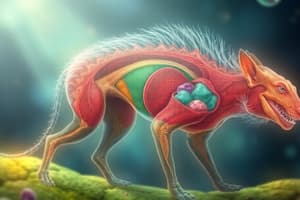Podcast
Questions and Answers
Which of the following correctly describes epithelial tissue?
Which of the following correctly describes epithelial tissue?
- Long thin cells that conduct electrical impulses
- Thin sheets of tightly packed cells covering surfaces and lining internal organs (correct)
- Thin sheets of loosely arranged cells that provide insulation
- Bundles of long cells that aid in movement
Muscle tissue is responsible for communication within the body.
Muscle tissue is responsible for communication within the body.
False (B)
What is the primary function of connective tissue?
What is the primary function of connective tissue?
Support and insulation
An organ system is formed when different ______ work together for one to a few purposes.
An organ system is formed when different ______ work together for one to a few purposes.
Match the type of tissue to its primary function:
Match the type of tissue to its primary function:
Flashcards
Tissue
Tissue
A group of similar cells that work together to perform a specific function.
Organ
Organ
Different tissues working together to perform a complex task specific to one organ.
Organ System
Organ System
A group of organs that work together to carry out a larger, more complex function for the body.
Cell
Cell
Signup and view all the flashcards
Epithelial tissue
Epithelial tissue
Signup and view all the flashcards
Study Notes
Animal Structure Hierarchy
- Cells are the basic living units in animals.
- Tissues are groups of similar cells working together for a specific function.
- Organs are composed of different tissues working together for a common function.
- Organ systems consist of different organs working towards one or more overall purposes.
- An organism is comprised of multiple organ systems functioning collectively for numerous needs.
Animal Tissues
- Epithelial Tissue: Forms thin, tightly packed sheets that cover body surfaces and line internal organs.
- Examples include skin and the lining of the digestive tract.
- Functions include protection against dehydration.
- Connective Tissue: Composed of various cells and fibers embedded in a matrix (liquid, solid, or gel).
- Examples include bones, tendons, and blood.
- Functions include support, insulation, and more.
- Muscle Tissue: Composed of bundles of long cells called muscle fibers with proteins enabling contraction.
- Examples include heart muscle, muscles surrounding the digestive tract, and muscles that move bones.
- Nervous Tissue: Consists of long, thin cells (neurons) with branches at their ends for conducting electrical impulses.
- Examples include the brain and nerves in sensory organs.
- Functions include communication within the body and coordinating bodily functions.
Studying That Suits You
Use AI to generate personalized quizzes and flashcards to suit your learning preferences.




